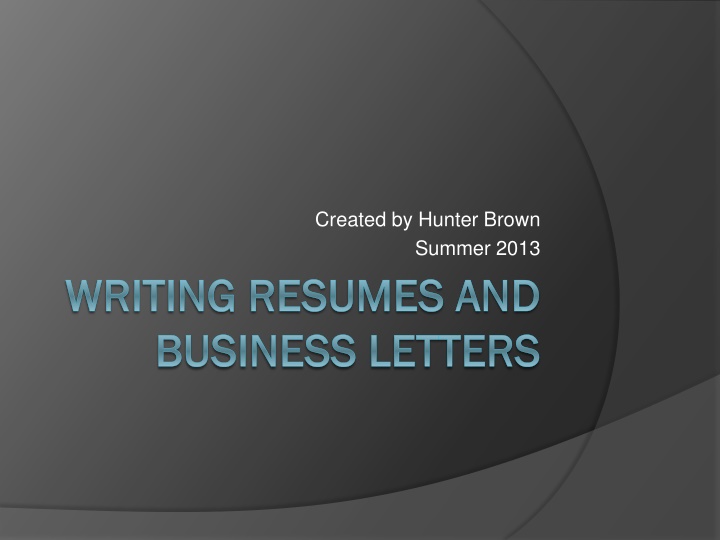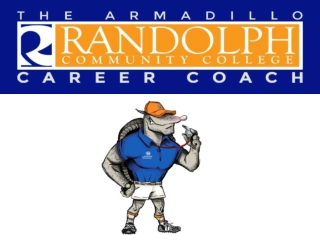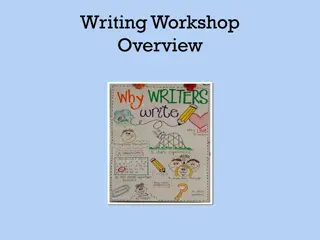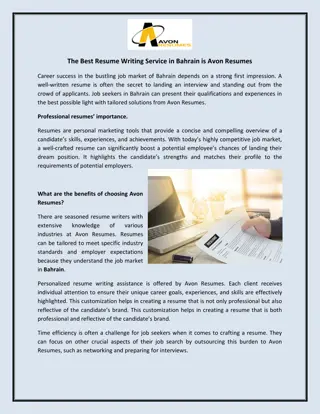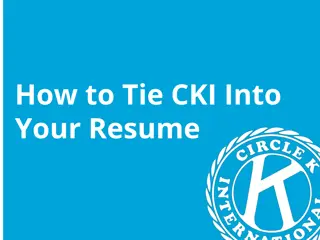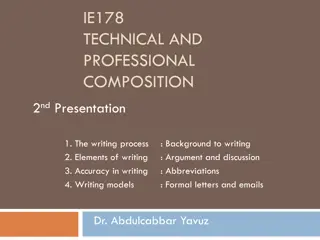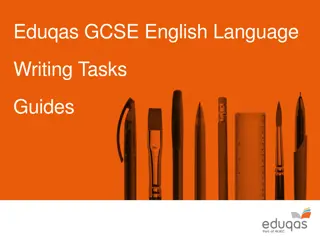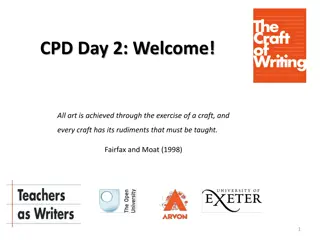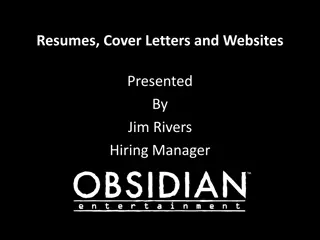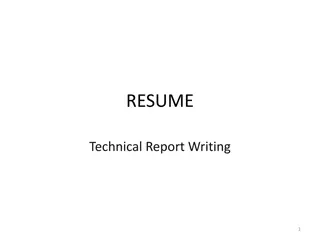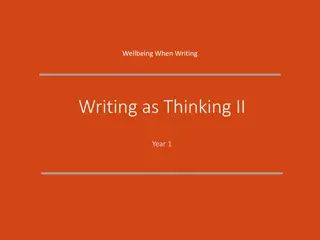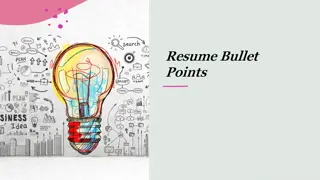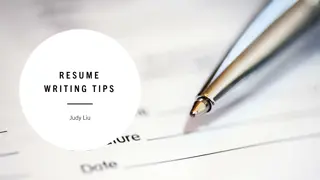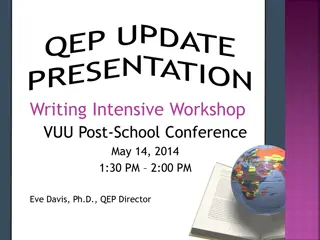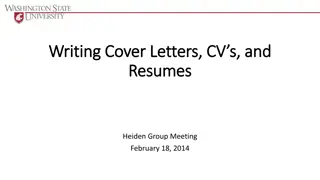Comprehensive Guide to Writing Effective Resumes
Crafting a compelling resume is crucial for capturing an employer's interest. Understand the purpose of a resume to secure that interview by showcasing your qualifications effectively. Learn about different resume types (chronological, functional, and combination) to tailor your resume to your strengths and work history. Dive into detailed sections like contact information and introductory statements to create a standout document that enhances your job prospects.
Download Presentation

Please find below an Image/Link to download the presentation.
The content on the website is provided AS IS for your information and personal use only. It may not be sold, licensed, or shared on other websites without obtaining consent from the author.If you encounter any issues during the download, it is possible that the publisher has removed the file from their server.
You are allowed to download the files provided on this website for personal or commercial use, subject to the condition that they are used lawfully. All files are the property of their respective owners.
The content on the website is provided AS IS for your information and personal use only. It may not be sold, licensed, or shared on other websites without obtaining consent from the author.
E N D
Presentation Transcript
Created by Hunter Brown Summer 2013 WRITING RESUMES AND WRITING RESUMES AND BUSINESS LETTERS BUSINESS LETTERS
Resumes A resume is a structured summary of a person s education, employment background, and job qualifications. Before you begin writing a resume, make sure you understand its true function as a brief persuasive business message intended to stimulate an employer s interest in meeting you and learning more about you. In other words, the purpose of a resume is not to get you a job but rather to get you an interview.
Types of Resumes 1. Chronological resume The most common approach. Work experience section dominates and is placed immediately after contact information and introductory statement. Lists jobs in reverse chronological order.
Types of Resumes 2. Functional resume Emphasizes your skills and capabilities. Stresses individual areas of competence rather than job history. Sometimes causes suspicion because it obscures work history.
Types of Resumes 3. Combination resume Meshes skills focus of functional resume with job history focus of chronological resume. Allows you to emphasize your capabilities if you don t have a long job history. A good choice for college students.
This is a sample combination resume. Created by Hunter Brown Summer 2013
Name and Contact Information Resumes should begin with the following contact information: Name Physical address Phone number(s) Email address URL of webpage (if you have one)
Introductory Statement The introductory statement can be structured in a number of ways: A career objective statement identifies either a specific job you want to land or a general career track you want to pursue. Avoid using unless you have no qualifications for, or employment background in, the career you are attempting to enter. A career summary offers a brief recap of your career. Use if you have a long work history. A qualifications summary offers a brief overview of your key qualifications. Use if you have a reasonably focused skill set but don t yet have a long career history. John Smith has chosen to use a qualifications summary.
Education Section The education section is your strongest selling point if you are still in or freshly out of college. Starting with the most recent, list the name and location of each school you have attended, the month and year of your graduation (or anticipated graduation in ___ ), major and minor fields of study, significant skills and abilities developed, and degrees or certifications gained.
Employment Section In the employment section, starting with the most recent, list the name of each company or establishment in which you ve worked, your position in the company, the name and location of the employer, and a brief description of the organization s purpose (optional).
Employment Section Include all full- and part-time jobs and internships that are relevant to the position for which you re applying. Also list military service, which is applicable to all jobs, and any bilingual or multilingual skills and experiences you have gained.
Employment Section Devote the most space to jobs that are directly related to your target position. John Smith is applying for an English teaching job, so he spends more time discussing his position as a Grammar Tutor than as a Piano Tutor.
Employment Section Notice that this applicant avoids using I and, instead, begins his bullet points with strong verbs.
Business Letters Choosing an Approach There are two main approaches to writing a business letter, one for bad news and one for good: 1. Use the direct approach when relaying a positive message. Start with the main idea and then give the evidence. Main idea: We have decided to award the contract to your firm. Evidence: You have more experience and better testimonials than any of your competitors.
Business Letters Choosing an Approach There are two main approaches to writing a business letter, one for bad news and one for good: 2. Use the indirect approach when relaying a negative message. Start with the evidence and build up to the main idea. Evidence: Our products don t come with a water damage warranty. Main idea: Unfortunately, we won t be able to grant your claim.
The You Attitude To turn the focus toward the audience, try to replace words such as I, me, mine, we, us, and our with you and yours. Change this: We have a wide variety of products to choose from. To this: You can choose from our wide variety of products. We will ship our newest toaster oven model to you as soon as we can. You should receive your new toaster oven by the beginning of next week.
Staying Polite and Emphasizing the Positive Try to maintain a courteous tone. Look for positive ways to relay negative news. When appropriate, use euphemisms words or phrases that express a thought in milder terms: senior citizens for old people restructuring for laying off
Staying Polite and Emphasizing the Positive Change this: To this: You have once again failed to follow protocol. Let s review company protocol and ensure that we are remaining compliant. After calling your firm multiple times without receiving the necessary information, we re beginning to get frustrated. The successful completion of this project depends on information only your firm can provide please send it to us at your earliest convenience. Your order should be filled by the end of next week. In the meantime, help yourself to our free online samples. We won t be able to fill your order until next week.
Style and Tone Style is made up of your word choices, sentence structures, and paragraph organization. These stylistic choices create a certain tone. When writing business letters, you want to use a tone that is more professional than conversational, but without sounding stuffy. Too Stuffy Professional I just learned that your plan for improving workflow is falling short of expectations. Too Casual It has come to my attention that your efforts to stimulate company growth have met with considerably less success than initially anticipated. So I found out that your big plan is basically failing. Ya ll have really let the ball drop.
Improving Readability Large blocks of text can be intimidating and difficult to read. Use lists to break content down into parallel items that can be easily scanned. Narrative List As you know, our competitors have been making drastic price cuts in the last quarter. Outmatching their price reductions would be difficult considering the following trends: As you know, our competitors have been making drastic price cuts in the last quarter and have somehow continued turning a profit, despite the rising steel costs. In addition, labor costs are rising, even in countries known for cheap labor, and hazardous waste regulations are adding to operating costs as well. These prohibitive costs would make outmatching our competitors price reductions difficult. Rising steel costs Rising labor costs Expensive hazardous waste regulations
Improving Readability Be generous with white space, a term referring to blank areas, such as margins, indents, and horizontal spaces between paragraphs. These white spaces make documents easier on the eyes. Your letter should be centered vertically (but not horizontally) on the page. If you need to add extra white space to center the letter, adjust the number of lines between the date and the inside address only. Centered Vertically Vertically Unbalanced 1 blank line 1 blank line July 11, 2013 July 11, 2013 Ms. Gambling 5050 Chance Blvd. Wetumpka, OK Ms. Gambling 5050 Chance Blvd. Wetumpka, OK 3 blank lines 3 blank lines 3 blank lines 1 blank line
Improving Readability Use a flush-left, ragged-right margin rather than a justified margin, which makes some lines look denser than others. Flush-left, ragged-right correct As you know, our competitors have been making drastic price cuts in the last quarter and have somehow continued turning a profit, despite the rising steel costs. Justified incorrect As you know, our competitors have been making drastic price cuts in the last quarter and have somehow continued turning a profit, despite the rising steel costs.
Letterhead This is a sample business letter with letterhead. Date Inside address Salutation Body Complimentary close Signature block
This is the same business letter without letterhead. Heading Date Inside address Salutation Body Complimentary close Signature block
Standard Letter Parts 1. Heading When letterhead stationary is unavailable, the heading should include a return address (without a name) and should start 13 lines from the top of the page, leaving a 2-inch top margin. 2. Date Place the date at least one blank line beneath the lowest part of the letterhead. If letterhead is unavailable, place the date directly below the return address. Standard date format includes the full name of the month, followed by the day, a comma, and then the year: August 31, 2012.
Standard Letter Parts 3. Inside Address The inside address identifies the recipient of the letter. Precede the recipient s name with a courtesy title such as Mr., Ms., or Dr. For businesswomen, the generally accepted business title is Ms. There are many personal, professional, and governmental titles, so do the necessary research to ensure that you use the correct one. 4. Salutation If the first line of the inside address is a person s name, the salutation should be Dear Mr. or Ms. Name, followed by a colon.
Standard Letter Parts 5. Body Single-space the body of your letter, and insert one blank line after the salutation, between paragraphs, and before the complimentary close. 6. Complimentary close Try to stick to one-word closings such as Sincerely or Cordially. 7. Signature Block To leave space for a written signature, insert three blank lines below the complimentary close, and then include the sender s name.
References Bovee, Courtland L., and John V. Thill. Business Communication Today. 11th ed. Boston: Pearson, 2012. Print.
